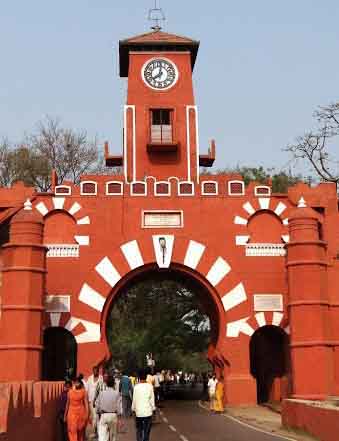Munger Fort

Information on Munger Fort (Munger, Bihar) - History & Architecture
Munger fort is regarded as the magnificent monuments of the Munger and is located at Munger, Bihar. The location of the fort is the rocky summit hillock, towards the south of the Ganga River. The construction of the fort is believed to be during the ear of the Slave Dynasty though the exact date inscription has not been clearly mentioned or it is on the blur image. The fort holds the total area of 222 acres.
The Munger fort has been annexed by many of the kings during its time and holds the history of the different rulers and the kings. Along with this it also houses many religious monuments. The tombs, of the various rulers can also be found while tour to the fort.
Munger Fort Architecture
The fort comprised of the strong and huge fortification during the Mughal rule, and was also expanded. The fort was constructed with the magnificent arrangements, which comprised of the gates which were massive and huge. On one side of the entrance had a fortification, which was with the tower designed in square figure, and had a moat which was deep. The construction of the moat was huge with 175 feet in width, and neighboring the fort's land from all side. The moat opens to the Gandes River, which formed as the security of the fort.
The fort walls comprises of 4 feet from inside and 12 feet from outside, and these are thick and forms a fortification which is about 30 feet. The walls of the fort have an intervening area which is 14 feet. The Ganges River that flows in the west side and partly in the north plays the part of the guardian for the fort as it protects from the immediate enemy attack, and the wide moat is the guardian of the fortification from the land side. There are four gateways and the main gate of the octagonal fort is called Lal Darwaza. Most parts of the fort are decayed and ruined but on the other hand the Lal Darwaza still stands strong and in a good shape. Carved stone is positioned in the doorway, which is believed to be either the structure of the Hindu or the Buddhist, though it is unsure, who does it belong to.
Munger Fort History
The Munger fort or the Killa has been dated back to the 1330 AD. It is believed that Mohhemadan Kings of India was the commissioner of the fort construction and came into existence in the 14th century. Muhamad Bin Tughluq was the ruler and the fort was under the supremacy of him and is dated from 1325-51.
The fort or the Killa comprises of the prominent summit and was reputed as Karnachaura or Karanchaura, whereas the other one is constructed in a rectangular mound and is regarded as the location for the citadel, and this beholds the history of the different and several ups and downs of the historical events.
The Fort was the came under the supremacy of different and several Muslim rulers who were the successions of one upon the other. The Muslim ruler was Khaljis, Tughlaqs, Lodhis, Nawab of Bengal, which went on until when Mir Quasim acceded it to the British in 1760-72. This was done for the monetary reward which was negotiated by Vansittart, after Mir Quasim unseated his father in law, Mir Jafar. The monitory reward included the payment which was done by the East India Company's merchant duty of 9% on the Indian merchant's duty of 40%. The fort also became the significant location for the British in Bengal till the date of the India's independence.
It is also believed that during the British Rule the fort also persisted with the White Mutiny which was brought down by Lord Clive in 1766. The mutiny collapsed due to the reduction of the additional payment which was also called as bhatta to soldiers. After the collapse of the mutiny the barracks was installed at the fort. The fort was under the control of the officer of the East India Company.
The tomb of Pir Shah Nafu, who died in 1494, tomb of Mulla Muhammas Said who collapsed in 1704 is also located in this fort. The maintenance of the fort was thereafter neglected for the years and over.
Munger Fort Tourism Importance
The tour to the fort has many to offer the visitors with, including the mysteries of the fort and the tombs that are placed within the fort. Not only there are tombs but also the palace of Shah Shuja, and the temple of the Goddess Chandi where the visitors can visit. The fort also gives an insight view of the historical past as well as the enriching architectural splendor, which has brought this structure to the people depicting the geniusness in architecture of the era. It is a must visit fort while in Munger in Bihar.
- Andaman Nicobar Monuments
- Andhra Pradesh Monuments
- Assam Monuments
- Bihar Monuments
- Chhattisgarh Monuments
- New Delhi Monuments
- Goa Monuments
- Gujarat Monuments
- Haryana Monuments
- Himachal Pradesh Monuments
- Jammu and Kashmir Monuments
- Karnataka Monuments
- Kerala Monuments
- Madhya Pradesh Monuments
- Maharashtra Monuments
- Odisha Monuments
- Punjab Monuments
- Rajasthan Monuments
- Tamil Nadu Monuments
- Telangana Monuments
- Uttar Pradesh Monuments
- West Bengal Monuments